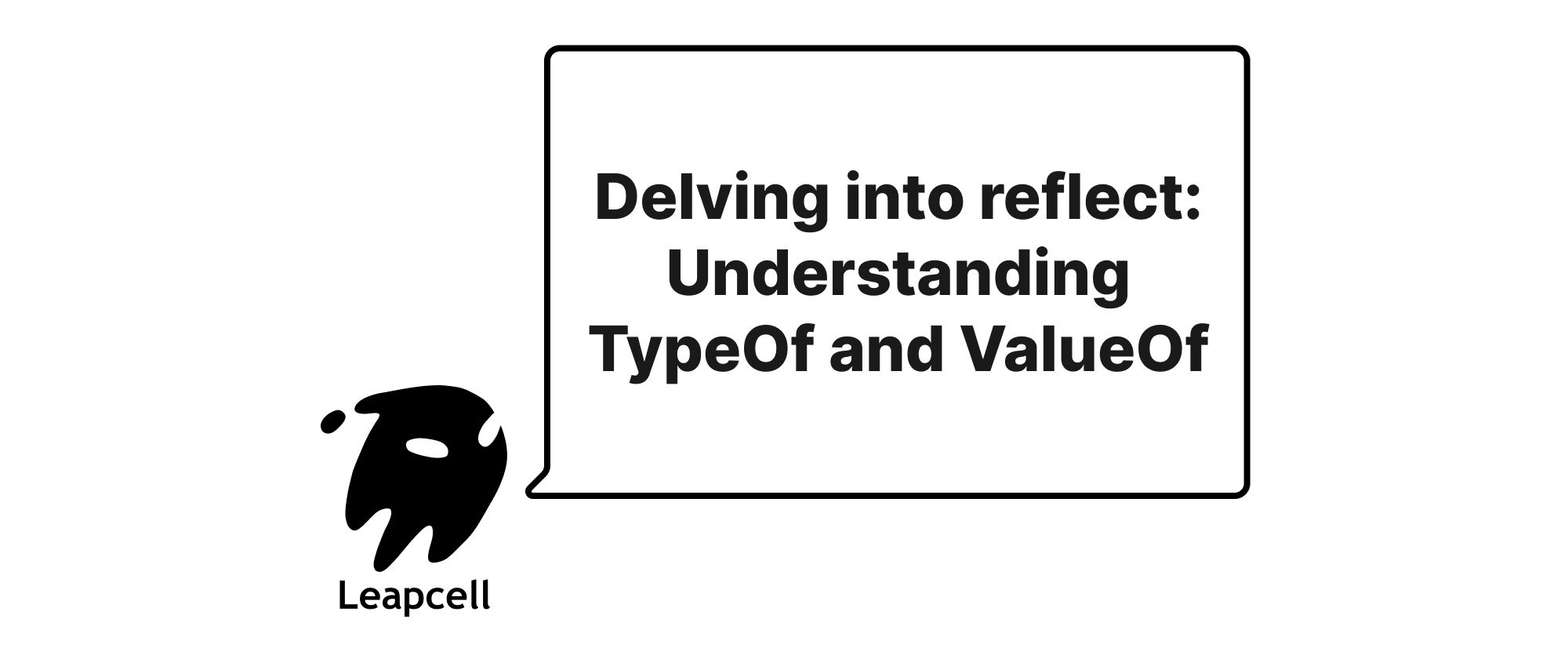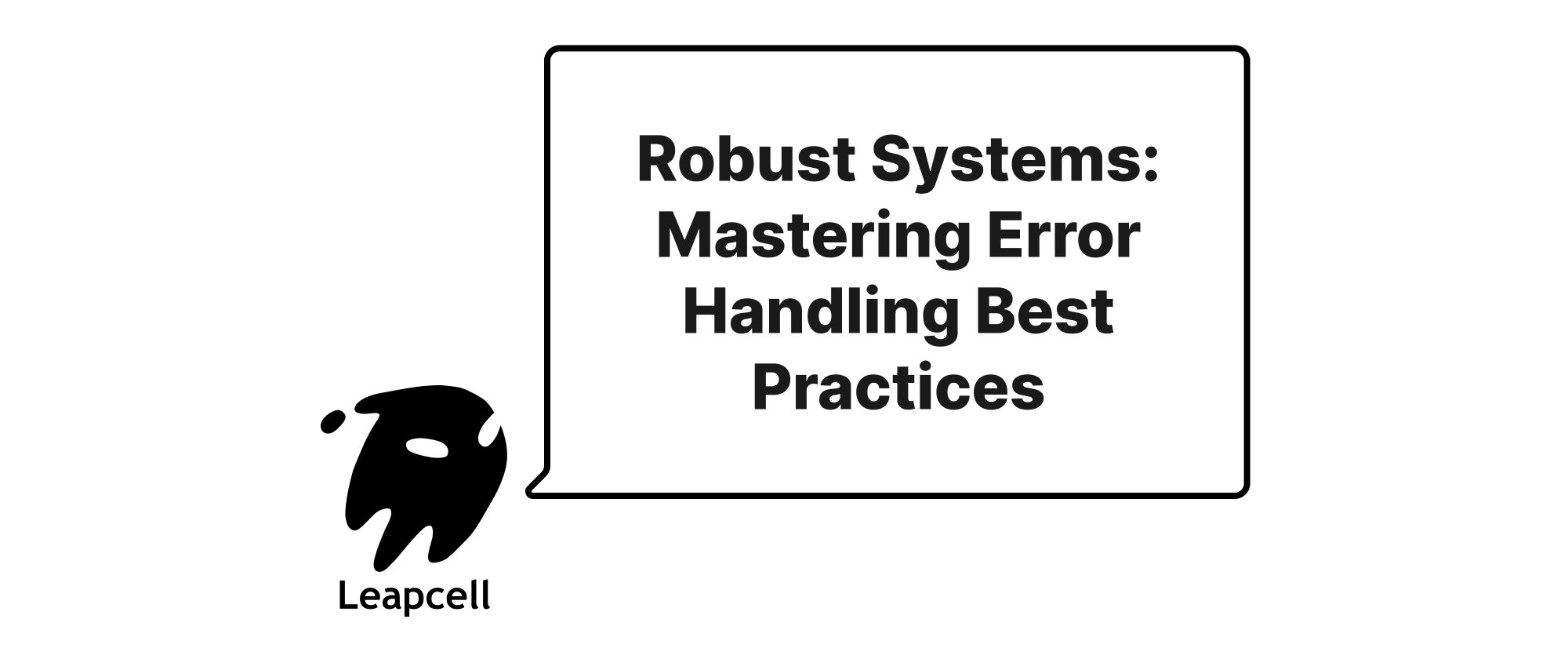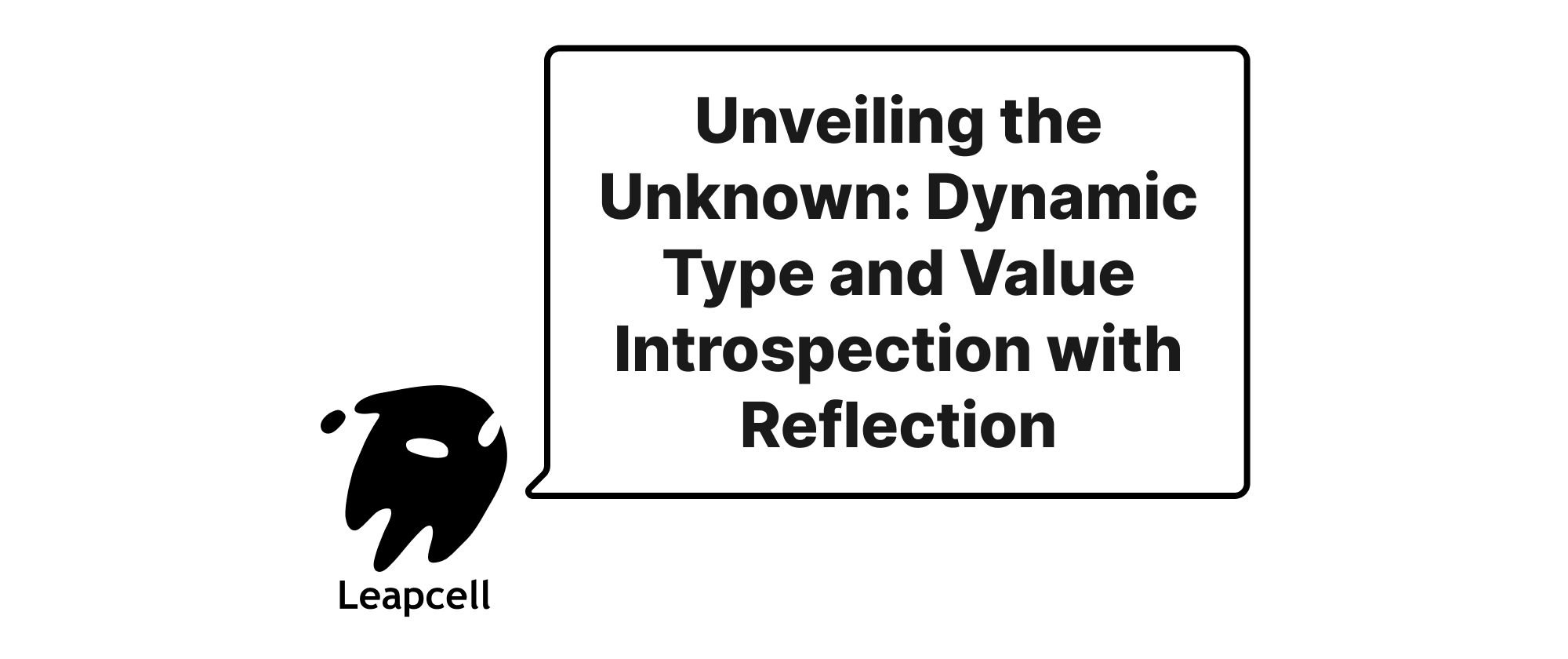Unveiling Go's Reflection: Deconstructing TypeOf and ValueOf
James Reed
Infrastructure Engineer · Leapcell

Go, born with an emphasis on performance and simplicity, often prefers static typing and compile-time checks. However, there are scenarios where the ability to inspect and manipulate types and values at runtime becomes invaluable. This is where Go's reflect package shines, providing the tools to achieve this dynamic behavior. At the heart of the reflect package lie two fundamental functions: TypeOf and ValueOf. Understanding their roles is the gateway to unlocking the power of Go reflection.
Reflection's Core: TypeOf and ValueOf
The reflect package doesn't provide direct access to the types and values of variables in the same way you might access them in other dynamic languages. Instead, it offers a distinct representation.
reflect.TypeOf: Unveiling the Type Information
The reflect.TypeOf function takes any interface value and returns a reflect.Type interface. This reflect.Type represents the dynamic type of the value passed to it. It provides a wealth of information about the type itself, such as its name, kind, underlying type, and even whether it's an array, slice, map, struct, or pointer.
Let's illustrate with some examples:
package main import ( "fmt" "reflect" ) func main() { var a int = 42 var b string = "hello Go" var c float64 = 3.14 var d []int = []int{1, 2, 3} var e map[string]int = map[string]int{"one": 1, "two": 2} var f struct { Name string Age int } = struct { Name string Age int }{"Alice", 30} var g *int = &a // Pointer to 'a' // Demonstrate TypeOf for various built-in types fmt.Println("--- TypeOf Examples ---") fmt.Printf("Type of 'a' (int): %v, Kind: %v\n", reflect.TypeOf(a), reflect.TypeOf(a).Kind()) fmt.Printf("Type of 'b' (string): %v, Kind: %v\n", reflect.TypeOf(b), reflect.TypeOf(b).Kind()) fmt.Printf("Type of 'c' (float64): %v, Kind: %v\n", reflect.TypeOf(c), reflect.TypeOf(c).Kind()) // Demonstrate TypeOf for composite types fmt.Printf("Type of 'd' ([]int): %v, Kind: %v\n", reflect.TypeOf(d), reflect.TypeOf(d).Kind()) fmt.Printf("Type of 'e' (map[string]int): %v, Kind: %v\n", reflect.TypeOf(e), reflect.TypeOf(e).Kind()) fmt.Printf("Type of 'f' (struct): %v, Kind: %v\n", reflect.TypeOf(f), reflect.TypeOf(f).Kind()) // Demonstrate TypeOf for a pointer fmt.Printf("Type of 'g' (*int): %v, Kind: %v\n", reflect.TypeOf(g), reflect.TypeOf(g).Kind()) // Accessing the element type of a pointer if reflect.TypeOf(g).Kind() == reflect.Ptr { fmt.Printf("Element Type of 'g': %v\n", reflect.TypeOf(g).Elem()) } // Custom type type MyString string var h MyString = "custom string" fmt.Printf("Type of 'h' (MyString): %v, Kind: %v\n", reflect.TypeOf(h), reflect.TypeOf(h).Kind()) }
Key observations from TypeOf:
reflect.Typeandreflect.Kind:reflect.TypeOf(x)returns areflect.Typeobject. To get the underlying category of the type (e.g.,Int,String,Slice,Struct,Ptr), you use the.Kind()method, which returns areflect.Kindconstant.- Pointer Types: When you use
TypeOfon a pointer, itsKind()isreflect.Ptr. To get the type of the value the pointer points to, you use the.Elem()method. This is crucial for dereferencing in reflection. - Custom Types: For user-defined types (like
MyString),TypeOfreturns the custom type name (main.MyString), but itsKind()still reflects its underlying type (string).
reflect.Type offers a rich API to query type information:
Name(): Returns the type's name within its package.PkgPath(): Returns the package path of the type.String(): Returns the string representation of the type.NumField(): For structs, returns the number of fields.Field(i): For structs, returns thereflect.StructFieldfor the i-th field.NumMethod(): For defined types, returns the number of methods.Method(i): For defined types, returns information about the i-th method.Key()andElem(): For maps and slices, return the types of their keys and elements respectively.
reflect.ValueOf: Interacting with the Value Itself
While reflect.TypeOf gives you information about the static type, reflect.ValueOf provides a reflect.Value interface that represents the dynamic value of an item. This reflect.Value object allows you to inspect the value held by a variable and, under certain conditions, even modify it.
package main import ( "fmt" "reflect" ) func main() { var x float64 = 3.14159 v := reflect.ValueOf(x) fmt.Println("\n--- ValueOf Examples ---") fmt.Printf("Value of 'x': %v\n", v) fmt.Printf("Type of 'x' (via ValueOf): %v\n", v.Type()) fmt.Printf("Kind of 'x' (via ValueOf): %v\n", v.Kind()) fmt.Printf("Is 'x' settable? %t\n", v.CanSet()) // Output: false // Trying to set a value that is not addressable/settable // This will panic: reflect: reflect.Value.SetFloat using unaddressable value // v.SetFloat(3.14) // Uncommenting this line will cause a panic // To modify a value using reflection, you must pass a *pointer* to it. // This makes the reflect.Value 'addressable' and therefore 'settable'. p := reflect.ValueOf(&x) // p is a Value representing *float64 fmt.Printf("Is 'p' (pointer to 'x') settable? %t\n", p.CanSet()) // Output: false (p itself isn't settable, but what it points to might be) fmt.Printf("Kind of 'p': %v\n", p.Kind()) // Output: ptr // To get the actual value the pointer points to: v = p.Elem() // v is now a Value representing the float64 that 'p' points to fmt.Printf("Value of 'x' (via pointer's Elem()): %v\n", v.Float()) fmt.Printf("Is 'v' (element of pointer) settable? %t\n", v.CanSet()) // Output: true if v.CanSet() { v.SetFloat(7.89) fmt.Printf("New value of 'x' after reflection: %f\n", x) // Output: 7.890000 } // Reflecting on a slice s := []int{10, 20, 30} sv := reflect.ValueOf(s) // sv is a Value representing []int fmt.Printf("Slice length: %d, capacity: %d\n", sv.Len(), sv.Cap()) fmt.Printf("First element: %d\n", sv.Index(0).Int()) // Example: Iterating over struct fields type Person struct { Name string Age int } person := Person{"Bob", 25} pv := reflect.ValueOf(person) pt := reflect.TypeOf(person) fmt.Println("Iterating over struct fields:") for i := 0; i < pv.NumField(); i++ { fieldValue := pv.Field(i) fieldType := pt.Field(i) fmt.Printf("Field %s (Type: %v, Kind: %v): Value: %v\n", fieldType.Name, fieldType.Type, fieldType.Type.Kind(), fieldValue) } }
Key observations from ValueOf:
reflect.Value:reflect.ValueOf(x)wraps the actual valuexin areflect.Valueobject.- Accessing Values: Similar to
reflect.Type,reflect.Valueoffers methods likeInt(),Float(),String()to retrieve the underlying value, based on its kind. - Addressability and Settability (
CanSet): This is perhaps the most important concept when trying to modify a value through reflection. Areflect.Valueis "settable" if it represents a value that can be changed. This is typically true for exported fields of an addressable struct, or the element of an addressable pointer.- When you pass
x(a copy ofx) toreflect.ValueOf(x), theValueOffunction receives a copy. Modifying this copy won't affect the originalx. Hence,v.CanSet()will befalse. - To make a value settable, you must pass a pointer to it to
reflect.ValueOf. Then, use.Elem()on the resultingreflect.Valueto get areflect.Valuethat represents the original variable itself. This derivedreflect.ValuewillCanSet()returntrue.
- When you pass
- Composite Types:
reflect.Valueprovides methods for manipulating composite types:Len()andCap()for slices, arrays, and maps.Index(i)for slices and arrays to get thereflect.Valueof an element.MapIndex(key)for maps to get thereflect.Valueof an element.Field(i)orFieldByName(name)for structs to get thereflect.Valueof a field. Note that fields must be exported (start with an uppercase letter) to be accessible and settable via reflection from outside their package.Call([]reflect.Value)for calling methods on areflect.Value.
Tangling Type and Value: Practical Applications
The real power emerges when you combine TypeOf and ValueOf for dynamic operations.
Example: Generic Printing (Type-Safe with Reflection)
Imagine you want a generic function that can print detailed information about any Go variable, without knowing its concrete type at compile time.
package main import ( "fmt" "reflect" ) // inspectAny takes an interface{} and prints detailed reflection info. func inspectAny(i interface{}) { if i == nil { fmt.Println(" Value is nil") return } val := reflect.ValueOf(i) typ := reflect.TypeOf(i) fmt.Printf("--- Inspecting: %v ---\n", i) fmt.Printf(" Actual Type: %v (Kind: %v)\n", typ, typ.Kind()) fmt.Printf(" Actual Value: %v\n", val) switch typ.Kind() { case reflect.Int, reflect.Int8, reflect.Int16, reflect.Int32, reflect.Int64: fmt.Printf(" Integer Value: %d\n", val.Int()) case reflect.Float32, reflect.Float64: fmt.Printf(" Float Value: %f\n", val.Float()) case reflect.String: fmt.Printf(" String Length: %d\n", val.Len()) fmt.Printf(" String Value: \"%s\"\n", val.String()) case reflect.Bool: fmt.Printf(" Boolean Value: %t\n", val.Bool()) case reflect.Slice, reflect.Array: fmt.Printf(" Length: %d, Capacity: %d\n", val.Len(), val.Cap()) fmt.Println(" Elements:") for i := 0; i < val.Len(); i++ { fmt.Printf(" [%d]: %v (Kind: %v)\n", i, val.Index(i), val.Index(i).Kind()) } case reflect.Map: fmt.Printf(" Map Length: %d\n", val.Len()) fmt.Println(" Keys and Values:") for _, key := range val.MapKeys() { fmt.Printf(" Key: %v (Kind: %v), Value: %v (Kind: %v)\n", key, key.Kind(), val.MapIndex(key), val.MapIndex(key).Kind()) } case reflect.Struct: fmt.Printf(" Number of Fields: %d\n", typ.NumField()) fmt.Println(" Fields:") for i := 0; i < typ.NumField(); i++ { field := typ.Field(i) fieldVal := val.Field(i) fmt.Printf(" - %s (Type: %v, Kind: %v)%s: %v\n", field.Name, field.Type, field.Type.Kind(), func() string { if !fieldVal.CanSet() { return " (Unsettable)" } return "" }(), fieldVal) } case reflect.Ptr: fmt.Printf(" Points to Type: %v\n", typ.Elem()) if !val.IsNil() { fmt.Printf(" Pointed Value: %v (Kind: %v)\n", val.Elem(), val.Elem().Kind()) // Recursively inspect the pointed-to value inspectAny(val.Elem().Interface()) } else { fmt.Println(" Pointer is nil") } case reflect.Func: fmt.Printf(" Number of In arguments: %d\n", typ.NumIn()) fmt.Printf(" Number of Out arguments: %d\n", typ.NumOut()) default: fmt.Printf(" Unhandled Kind: %v\n", typ.Kind()) } fmt.Println("---------------------\n") } func main() { inspectAny(123) inspectAny("Hello Reflection!") inspectAny([]float64{1.1, 2.2, 3.3}) inspectAny(map[string]bool{"apple": true, "banana": false}) type Address struct { Street string Number int City string // Exported field zipCode string // Unexported field } addr := Address{"Main St", 100, "Anytown", "12345"} inspectAny(addr) var ptrToInt *int = new(int) *ptrToInt = 500 inspectAny(ptrToInt) var nilPtr *string // A nil pointer inspectAny(nilPtr) // Example with a function myFunc := func(a, b int) int { return a + b } inspectAny(myFunc) }
This inspectAny function demonstrates how TypeOf and ValueOf work hand-in-hand. TypeOf helps us determine the type category (its Kind), allowing us to use a switch statement for specific handling. ValueOf then lets us extract the actual data using methods like Int(), String(), Index(), MapKeys(), Field(), etc.
Caveats and Considerations
Reflection in Go is powerful, but it's not without its drawbacks:
- Performance: Reflection operations are typically much slower than direct, type-safe operations. This is because they involve runtime type checks and dynamic memory allocation. Avoid using reflection for performance-critical inner loops.
- Safety: Reflection bypasses Go's static type checks. Incorrect usage (e.g., trying to convert a
float64toInt()without checking its kind) will lead to runtime panics. - Complexity: Code that heavily relies on reflection can be harder to read, understand, and debug compared to statically typed code.
interface{}: BothTypeOfandValueOfoperate oninterface{}. When you pass a concrete type to them, Go performs an implicit boxing operation, placing the value into aninterface{}. This is howreflectgets access to the dynamic type and value information.- Exported Fields: Remember the rule for settability: only exported fields of structs (those starting with an uppercase letter) can be retrieved and modified by reflection from outside their package. Unexported fields are inaccessible.
Conclusion
reflect.TypeOf and reflect.ValueOf are the foundational building blocks of Go's reflection capabilities. TypeOf unravels the static type information (its identity, kind, structure), while ValueOf provides access to the dynamic data held by a variable. By understanding their distinct roles and how they interact, especially with the critical concept of "addressability" and "settability," you gain the ability to write more flexible and dynamic Go programs.
While reflection is a potent tool, it should be used judiciously. Its primary use cases include:
- Serialization/Deserialization: Marshalling and unmarshalling data (e.g., JSON, XML, ORM frameworks).
- ORM and Database Mappers: Mapping Go structs to database tables.
- Dependency Injection Frameworks: Assembling components without hardcoding dependencies.
- Testing Utilities: Introspecting test subjects or mocking dependencies.
- Generic Utility Functions: Writing generic functions that operate on various types (like our
inspectAnyexample).
Mastering TypeOf and ValueOf is your first step into the intriguing world of Go reflection, enabling you to build highly adaptable and extensible systems. Tread carefully, and let Go's reflective power elevate your applications.


